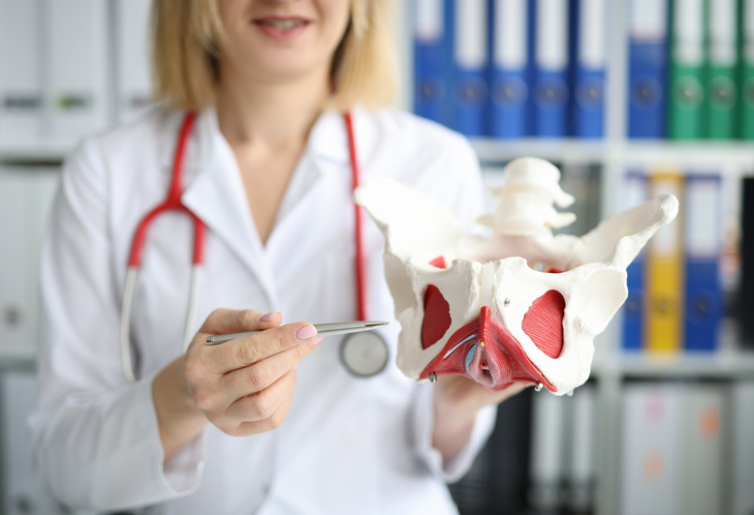
Stop Doing These 7 Things for Better Pelvic Health

What is pelvic health?
Pelvic health is optimal functioning of bowel, bladder and reproductive organs. It is proper alignment and good strength and mobility of the muscles of the pelvis, our bodies foundation. It is the absence of dysfunction and pain in your pelvis and pelvic organs. Dysfunction can be bowel or bladder incontinence, pain with intercourse or mobility, and pelvic organ prolapse. Pelvic health plays a large role in overall health and wellness, as it affects physical, sexual, mental, and social wellbeing.
Sounds like something you want in working order, right?!
It seems like our to-do list keeps growing in motherhood, so instead of adding to that list let’s focus on things we can avoid instead.
Here are 7 simple things to avoid to improve pelvic health
Power Peeing
Power peeing is when you are in a rush (as we often are) and we try to force out urine more quickly. There is a big push to get the urine out and this isn’t helpful. When urinating we want our pelvic floor to relax the sphincter to open and urine should flow out without force. Over time trying to force urine out can lead to poor coordination of the pelvic floor muscles and dysfunction starts.
To avoid this make sure you are fully seated, no hovering, take a deep breath and do your best to relax and take the time you need. No need to push the urine out.

Chronic constipation
This can be a bit of the chicken and the egg. Chronic constipation can lead to pelvic floor issues AND can also be a symptom of pelvic floor dysfunction.
Constipation leads to pressure on the pelvic floor and nerves in that area as the rectum and large intestines stay full and also leads to straining of the pelvic floor when trying to have a bowel movement. This can lead to weakening of the pelvic floor muscles. Beth Israel has a great resource on constipation and pelvic floor.
Conversely it can be a symptom of pelvic floor dysfunction if the muscles around the rectum are too tight and unable to relax to let stool pass.
Tips to avoid constipation include:
Stay hydrated – moisture in stool keeps it soft and easier to pass
Stay active – aerobic exercise aids motility, walking also is great. Avoid exercise right after eating though so blood flow doesn’t get redirected from stomach and intestines to skeletal muscles
Add more fiber to your diet – foods such as prunes, apples, lentils, chia and flax seeds are helpful
Avoid straining – use a step stool or squatty potty
Wearing a pony tail while driving.
Seems strange but let me explain. We are all connected. Your posture affects your pelvic floor. Forward head postures also usually go hand in hand with slumped postures which have been shown to have less pelvic floor activation. Harvard states incontinence and constipation as 2 of 3 surprising risks of poor posture.
Also your head is heavy which isn’t usually an issue if it is stacked above our shoulders. However for every 1 inch your head is forward it essentially adds about 10 lbs of load onto your spine putting more pressure onto your pelvic floor and making it have to work harder.
So avoid things that perpetuate poor posture and a forward head. Simple changes like having your hair down while driving or at work can be helpful. If you are wearing a lower bun or pony tail the back of your head isn’t able to rest against the backrest – instead it is pushed forward slightly into a forward head position. Attempting to decrease how many pillows you use can also be helpful.

Constant Kegals
Kegals are touted as the thing to do to strengthen your pelvic floor. Of course we want a strong pelvic floor. But we also want a functional pelvic floor which means good length tension relationship of the muscles and good coordination.
Here’s the thing, we can not strengthen an already short and too tense muscle. Your attempts at strengthening can either be in vain or make symptoms worse by only further adding to the tension that is already there.
Don’t get me wrong there is a time and a place for kegals but we often need to learn to relax and lengthen our pelvic floor as well. Also it is one thing to work on strengthening but if we are constantly trying to strengthen because they are easy enough to do everywhere we can also make symptoms worse. Our pelvic floors should not be contracted all the time it needs to be able to coordinate to the movements we are doing and also to how we are breathing.
Constant kegals can lead to issues with proper motor coordination. An example is with running. We should not be constantly contracting our pelvic floor while running. It needs to act as a shock absorber and to do this needs to contract and relax. Constant contraction can lead to pelvic pain while running.
Sucking in your belly
So many reasons to stop this bad habit and pelvic health is one of them!
As you suck in your belly one is generally sucking in or pulling the belly in on the inhale. This wracks havoc on proper coordination as your diaphragm is supposed to drop down and you actually get expansion in the ribs and your abdomen during the inhale not the other way around. This also messes with our pressure management. When we suck in our belly we typically tighten up towards the top of our abdomen and this puts increased pressure on our pelvic floor.
Over time increased pressure and poor pressure management can lead to impaired coordination, weakness and pelvic floor dysfunction.
Living in shape-wear or too tight pants
Size does matter. This is for the same reasons as above, it causes too much pressure on your pelvic floor and can lead to dysfunction. Wearing pants that are too tight, or compression garments should be avoid especially if you are noticing any pelvic floor issues such as pain or incontinence.
Mama you deserve to feel comfortable and yes your shape is just fine as is! No shape-wear required.
Blowing your nose on the toilet
For better pelvic floor health and function stop blowing your nose while going to the bathroom. I know I can’t be the only one to do this right? But I am mindfully breaking the habit for better pelvic health.
Blowing your nose on the toilet trains dysfunction. When you are going to the bathroom your pelvic floor needs to relax. As you blow your nose your pelvic floor needs to lift. Awareness to how your body moves and what it is doing is after the first step to preventing dysfunction. From here you can also work on repair and proper function.

Found this helpful and want more tips grab my free guide Take Care Down There: Postpartum Pelvic Recovery Guide
Thank you for sharing!
Struggling with postpartum pelvic pain, leaks, or discomfort? Download your FREE Postpartum Pelvic Recovery Guide and learn simple, expert-backed strategies to heal, strengthen, and feel like yourself again. Because your recovery matters—let’s take care down there!
